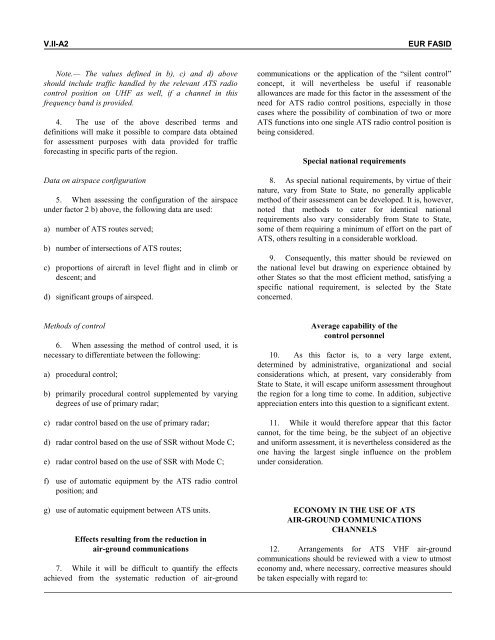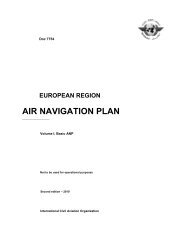7754 Vol 2 Flyleaf - ICAO Public Maps
7754 Vol 2 Flyleaf - ICAO Public Maps
7754 Vol 2 Flyleaf - ICAO Public Maps
You also want an ePaper? Increase the reach of your titles
YUMPU automatically turns print PDFs into web optimized ePapers that Google loves.
V.II-A2<br />
EUR FASID<br />
Note.— The values defined in b), c) and d) above<br />
should include traffic handled by the relevant ATS radio<br />
control position on UHF as well, if a channel in this<br />
frequency band is provided.<br />
4. The use of the above described terms and<br />
definitions will make it possible to compare data obtained<br />
for assessment purposes with data provided for traffic<br />
forecasting in specific parts of the region.<br />
Data on airspace configuration<br />
5. When assessing the configuration of the airspace<br />
under factor 2 b) above, the following data are used:<br />
a) number of ATS routes served;<br />
b) number of intersections of ATS routes;<br />
c) proportions of aircraft in level flight and in climb or<br />
descent; and<br />
d) significant groups of airspeed.<br />
communications or the application of the “silent control”<br />
concept, it will nevertheless be useful if reasonable<br />
allowances are made for this factor in the assessment of the<br />
need for ATS radio control positions, especially in those<br />
cases where the possibility of combination of two or more<br />
ATS functions into one single ATS radio control position is<br />
being considered.<br />
Special national requirements<br />
8. As special national requirements, by virtue of their<br />
nature, vary from State to State, no generally applicable<br />
method of their assessment can be developed. It is, however,<br />
noted that methods to cater for identical national<br />
requirements also vary considerably from State to State,<br />
some of them requiring a minimum of effort on the part of<br />
ATS, others resulting in a considerable workload.<br />
9. Consequently, this matter should be reviewed on<br />
the national level but drawing on experience obtained by<br />
other States so that the most efficient method, satisfying a<br />
specific national requirement, is selected by the State<br />
concerned.<br />
Methods of control<br />
6. When assessing the method of control used, it is<br />
necessary to differentiate between the following:<br />
a) procedural control;<br />
b) primarily procedural control supplemented by varying<br />
degrees of use of primary radar;<br />
c) radar control based on the use of primary radar;<br />
d) radar control based on the use of SSR without Mode C;<br />
e) radar control based on the use of SSR with Mode C;<br />
Average capability of the<br />
control personnel<br />
10. As this factor is, to a very large extent,<br />
determined by administrative, organizational and social<br />
considerations which, at present, vary considerably from<br />
State to State, it will escape uniform assessment throughout<br />
the region for a long time to come. In addition, subjective<br />
appreciation enters into this question to a significant extent.<br />
11. While it would therefore appear that this factor<br />
cannot, for the time being, be the subject of an objective<br />
and uniform assessment, it is nevertheless considered as the<br />
one having the largest single influence on the problem<br />
under consideration.<br />
f) use of automatic equipment by the ATS radio control<br />
position; and<br />
g) use of automatic equipment between ATS units.<br />
Effects resulting from the reduction in<br />
air-ground communications<br />
7. While it will be difficult to quantify the effects<br />
achieved from the systematic reduction of air-ground<br />
ECONOMY IN THE USE OF ATS<br />
AIR-GROUND COMMUNICATIONS<br />
CHANNELS<br />
12. Arrangements for ATS VHF air-ground<br />
communications should be reviewed with a view to utmost<br />
economy and, where necessary, corrective measures should<br />
be taken especially with regard to:














